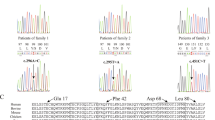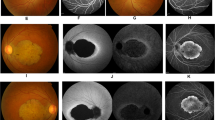Abstract
Background
To report the results of the GUCY2D gene mutation analysis in a cohort of Chinese patients with cone or cone–rod dystrophies (COD or CORD) and to describe the clinical features observed in patients with molecularly confirmed COD or CORD.
Methods
A total of 74 probands clinically diagnosed with COD or CORD were recruited for genetic analysis; these included 15 unrelated patients with a positive family history consistent with an autosomal dominant pattern of inheritance and 59 unrelated sporadic cases. All probands underwent ophthalmic examinations including best-corrected visual acuity, fundus examination, optical coherence tomography, and electroretinography. Genomic DNA was extracted from venous blood of all participants, and all coding exons and exon–intron boundaries of the GUCY2D gene were screened for mutations by PCR-based DNA sequencing. Restriction fragment length polymorphism analysis and allele-specific PCR analysis were used to validate the substitution in all available family members.
Results
Four different GUCY2D missense mutations—three affected codon 838 and one affected codon 849—were identified in nine unrelated probands. Mutation p.R838H was identified in four probands, while both mutations p.R838C and p.R838P were found in two unrelated patients, and mutation p.T849A was found in one proband. The GUCY2D mutations were found in 47 % of the patients (7/15) with autosomal dominant cone dystrophy. Patients with mutation p.R838P presented a relatively severe clinical phenotype.
Conclusion
The GUCY2D mutations were frequent in Chinese families with autosomal dominant cone or cone–rod dystrophies. All mutations were found in exon 13, which should be given priority during mutation screening analysis.




Similar content being viewed by others
References
Hamel CP (2007) Cone rod dystrophies. Orphanet J Rare Dis 2:7. doi:10.1186/1750-2-7
Michaelides M, Hardcastle AJ, Hunt DM, Moore AT (2006) Progressive cone and cone-rod dystrophies: phenotypes and underlying molecular genetic basis. Surv Ophthalmol 51:232–258
Kelsell R, Gregory-Evans K, Payne A, Perrault I, Kaplan J, Yang RB, Garbers DL, Bird AC, Moore AT, Hunt DM (1998) Mutations in the retinal guanylate cyclase (RETGC-1) gene in dominant cone-rod dystrophy. Hum Mol Genet 7:1179–1184
Hunt DM, Buch P, Michaelides M (2010) Guanylate cyclases and associated activator proteins in retinal disease. Mol Cell Biochem 334:157–168
Gregory-Evans K, Kelsell R, Gregory-Evans C, Downes SM, Fitzke FM, HolderGR Simunovic M, Mollon JD, Taylor R, Hunt DM, Bird AC, Moore AT (2000) Autosomal dominant cone rod retinal dystrophy (CORD6) from heterozygous mutation of GUCY2D, which encodes retinal guanylate cyclase. Ophthalmology 107:55–61
Payne AM, Morris AG, Downes SM, Johnson S, Bird AC, Moore AT, Bhattacharya SS, Hunt DM (2001) Clustering and frequency of mutations in the retinal guanylate cyclase (GUCY2D) gene in patients with dominant cone-rod dystrophies. J Med Genet 38:611–614
Downes SM, Payne AM, Kelsel RE, Fitzke FW, Holder GE, Hunt DM, Moore AT, Bird AC (2001) Autosomal dominant cone-rod dystrophy with mutations in the guanylate cyclase 2D gene encoding retinal guanylate cyclase-1. Arch Ophthalmol 119:1667–1673
Udar N, Yelchits S, Chalukya M, Yellore V, Nusinowitz S, Silva-Garcia R, Vrabec T, Hussles Maumenee I, Donoso L, Small KW (2003) Identification of GUCY2D gene mutations in CORD5 families and evidence of incomplete penetrance. Hum Mutat 21:170–171
Ito S, Nakamura M, Nuno Y, Ohnishi Y, Nishida T, Miyake Y (2004) Autosomal dominant cone-rod dystrophy with R838H and R838C mutations in the GUCY2D gene in Japanese patients. Jpn J Ophthalmol 48:228–235
Ito S, Nakamura M, Nuno Y, Ohnishi Y, Nishida T, Miyake Y (2004) Novel complex GUCY2D mutation in Japanese family with cone-rod dystrophy. Invest Ophthalmol Vis Sci 45:1480–1485
Yoshida S, Yamaji Y, Yoshida A, Kuwahara R, Yamamoto K, Kubata T, Ishibashi T (2006) Novel triple missense mutations of GUCY2D gene in Japanese family with cone-rod dystrophy: possible use of genotyping microarray. Mol Vis 12:1558–1564
Smith M, Whittock N, Searle A, Croft M, Brewer C, Cole M (2007) Phenotype of autosomal dominant cone-rod dystrophy due to the R838C mutation of the GUCY2D gene encoding retinal guanylate cyclase-1. Eye (Lond) 21:1220–1225
Kitiratschky VB, Wilke R, Renner AB, Kellner U, Vadala M, Birch DG, Wissinger B, Zrenner E, Kohl S (2008) Mutation analysis identifies GUCY2D as the major gene responsible for autosomal dominant progressive cone degeneration. Invest Ophthalmol Vis Sci 49:5015–5023
Cremers FPM, van den Hurk JAJM, den Hollander AI (2002) Molecular genetics of Leber congenital amaurosis. Hum Mol Genet 11:1169–1176
den Hollander AI, Roepman R, Koenekoop RK, Cremers FPM (2008) Leber congenital amaurosis: genes, proteins and disease mechanisms. Prog Retin Eye Res 27:391–419
Auz-Alexandre CL, Vallespin E, Aguirre-Lamban J, Cantalapiedra D, Avila-Fernandez A, Villaverde-Montero C, Ainse E, Trujillo-Tiebas MJ, Ayuso C (2009) Novel human pathological mutations. Gene symbol: GUCY2D. Disease: Leber congenital amaurosis. Hum Genet 125:349
Zhao X, Ren Y, Zhang X, Chen C, Dong B, Li Y (2013) A novel GUCY2D mutation in a Chinese family with dominant cone dystrophy. Mol Vis 19:1039–1046
Ugur Iseri SA, Durlu YK, Tolun A (2010) A novel recessive GUCY2D mutation causing cone-rod dystrophy and not Leber’s congenital amaurosis. Eur J Hum Genet 18:1121–1126
Weigell-Weber M, Fokstuen S, Torok B, Niemeyer G, Schinzel A, Hergersberg M (2000) Codons 837 and 838 in the retinal guanylate cyclase gene on chromosome 17p: hot spots for mutations in autosomal dominant cone-rod dystrophy? Arch Ophthalmol 118:300
Garcia-Hoyos M, Auz-Alexandre CL, Almoguera B, Cantalapiedra D, Riveiro-Alvarez R, Lopez-Martinez MA, Gimenez A, Blanco-Kelly F, Avila-Fernandez A, Trujillo- Tiebas MJ, Garcia-Sandoval B, Ramos C, Ayuso C (2011) Mutation analysis at codon 838 of the Guanylate Cyclase 2D gene in Spanish families with autosomal dominant cone, cone-rod, and macular dystrophies. Mol Vis 17:1103–1109
Xiao X, Guo X, Jia X, Li S, Wang P, Zhang Q (2011) A recurrent mutation in GUCY2D associated with autosomal dominant cone dystrophy in a Chinese family. Mol Vis 17:3271–3278
Kohl S, Kitiratschky V, Papke M, Schaich S, Sauer A, Wissinger B (2012) Genes and mutations in autosomal dominant cone and cone-rod dystrophy. Adv Exp Med Biol 723:337–343. doi:10.1007/978-1-4614-0631-0_44
Xu F, Dong F, Li H, Li X, Jiang R, Sui R (2013) Phenotypic characterization of a Chinese family with autosomal dominant cone–rod dystrophy related to GUCY2D. Doc Ophthalmol 126:233–240
Lazar CH, Mutsuddi M, Kimchi A, Zelinger L, Mizrahi-Meissonnier L, Marks-Ohana D, Boleda A, Ratnapriya R, Sharon D, Swaroop A, Banin E (2014) Whole exome sequencing reveals GUCY2D as a major gene associated with cone and cone-rod dystrophy in Israel. Invest Ophthalmol Vis Sci 16:420–430. doi:10.1167/iovs.14-15647
McCulloch DL, Marmor MF, Brigell MG, Hamilton R, Holder GE, Tzekov R, Bach M (2015) ISCEV Standard for full-field clinical electroretinography (2015 update). Doc Ophthalmol 130:1–12. doi:10.1007/s10633-014-9473-7
Boon CJ, Klevering BJ, Cremers FP, Zonneveld-Vrieling MN, Theelen T, DenHollander AI, Hoyng CB (2009) Central areolar choroidal dystrophy. Ophthalmology 116:771–782
Acknowledgments
We thank the patients and their families for participating in this study. The study was supported by the High-level Talents training plan of the health system of Beijing (No, 2013-2-021).
Author information
Authors and Affiliations
Corresponding author
Ethics declarations
Conflict of interest
All authors certify that they have no affiliations with or involvement in any organization or entity with any financial interest (such as honoraria; educational grants; participation in speakers’ bureaus; membership, employment, consultancies, stock ownership, or other equity interest; and expert testimony or patent-licensing arrangements), or non-financial interest (such as personal or professional relationships, affiliations, knowledge, or beliefs) in the subject matter or materials discussed in this manuscript.
Ethical approval
The article is a clinical research on eye disease and the research was performed in accordance with the Declaration of Helsinki, which has been described in the paper. The paper did not involve in animals and all patients had signed the informed consents which had been stated in the paper.
Rights and permissions
About this article
Cite this article
Jiang, F., Xu, K., Zhang, X. et al. GUCY2D mutations in a Chinese cohort with autosomal dominant cone or cone–rod dystrophies. Doc Ophthalmol 131, 105–114 (2015). https://doi.org/10.1007/s10633-015-9509-7
Received:
Accepted:
Published:
Issue Date:
DOI: https://doi.org/10.1007/s10633-015-9509-7




